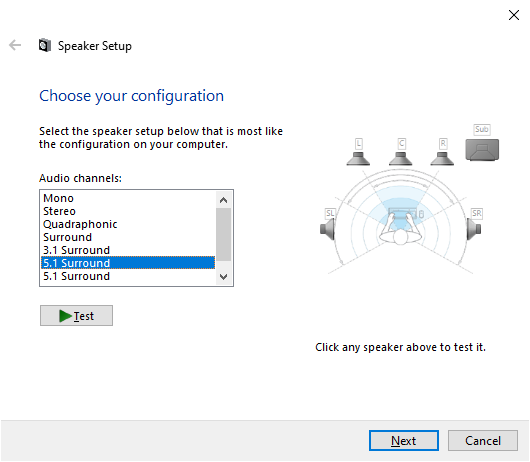(There are so many ‘S’s in the title.)
Scream is an open-source virtual network sound card for Windows. It sends uncompressed sound PCM data over multicast (hence ‘scream’) UDP or optionally unicast UDP packets. Even though uncompressed, the bandwidth of a 7.1 channel, 16bit, 48kHz PCM stream is only 6.14Mbps, well within the capabilities of today’s WiFi hardware.
PHICOMM R1 is a smart speaker whose cloud service had been shut down and not ‘smart’ anymore so I’m able to get an unused one for about $11 in China. It comes with Android 5.1, 5GHz WiFi and an open network ADB port, which make it a decent wireless speaker node.
Today we’re going to set up a 5.1 wireless surround speaker system for a PC (running Windows) with 6 PHICOMM R1 speakers.
While multicast works well in wired networks, multicast in WiFi has several limitations that make me turn to unicast instead. First, for most of the time, wireless AP can’t transmit multicast packets continuously and bandwidth is limited; Second, multicast packets don’t have retransmission mechanisms so that they are prone to data loss, which is unbearable in our case.
So I created a fork on my GitHub to add the functionality of splitting multi-channel audio over multiple destinations (e.g. Front Left and Front Center to 192.168.0.2, while Front Center and Front Right to 192.168.0.3).
Build and Install Scream on Windows
Configure Endpoints in the Source Code
At the time of writing (commit 090f873), destination(endpoint) info is hard-coded in Scream/savedata.cpp temporarily. So you should change the constructor of CSaveData class and some array declarations in CSaveData::Initialize to suit your environment:
CSaveData::CSaveData() : m_bNumEndPoints(6), ...
{
...
}
...
NTSTATUS CSaveData::Initialize(...) {
...
PCHAR ips[] = {
"192.168.90.241",
"192.168.90.242",
"192.168.90.243",
"192.168.90.244",
"192.168.90.245",
"192.168.90.246"
};
USHORT ports[] = { 4010, 4010, 4010, 4010, 4010, 4010 };
WORD masks[] = { 0x1, 0x2, 0x400, 0x200, 0x4, 0x8 };
...
}
The array WORD masks[] stores information about what channels to send to each endpoint. The mapping between bitfields and audio channels can be found at KSAUDIO_CHANNEL_CONFIG structure documentation. Therefore the code above shows the channels sent to endpoint 0 through 5 are Front Left (0x1), Front Right (0x2), Side Right (0x400), Side Left (0x200), Front Center (0x4) and Low Frequency (0x8), respectively. You can have multiple bits set in certain members of masks[] if you want.
Build with Visual Studio
Scream is a Windows device driver running in kernel space. Building it requires Visual Studio with C++ components and Windows Driver Kit (WDK), which must be installed separately.
Launch Visual Studio Installer and make sure something similar to MSVC v142 – VS2019 C++ x64/x86 Spectre-mitigated libs (v14.24), C++ ATL for latest v142 build tools with Spectre Mitigations (x86 & x64) and MSVC v142 – VS2019 C++ x64/x86 build tools are installed.
Start Visual Studio and open Scream.sln, Click Build -> Build Solution to build our driver file. There are 3 files generated: scream.cat, Scream.inf and Scream.sys.
The build process should complete without error. If the linker complains about undefined reference, right-click Scream (in the Solution Explorer) -> Properties -> Configuration Properties -> Linker -> Input -> Additional Dependencies and add 3 libraries:
$(DDK_LIB_PATH)portcls.lib $(DDK_LIB_PATH)netio.lib $(DDK_LIB_PATH)stdunk.lib
If you want to debug the driver, you should prepare another PC or virtual machine running Windows and refer to Deploying a Driver to a Test Computer.
Install Scream on Your PC
Sadly, before I’m able to get a certificate for the driver, one must disable Signed Driver Enforcement before installing it.
Locate devcon.exe provided by WDK — typically inside C:\Program Files (x86)\Windows Kits\10\Tools\x64 — and launch a Command Prompt or PowerShell in administrator mode here.
Run .\devcon.exe remove *Scream if you want to remove previously installed Scream.
Run .\devcon.exe install path\to\Scream.inf *Scream to install.
A warning should show up. Click Install anyway or similar buttons.
Build and Install scream-android on PHICOMM R1
There is a simple Scream receiver for Android that can run on our R1 with a little modification.
Build scream-android with Android Studio
Download and install the latest Android Studio, clone the code and open the project in Android Studio.
Click Build -> Build Bundle(s) / APK(s) -> Build APK(s) to generate the .apk file.
Install scream-android on PHICOMM R1
Locate your ADB executable provided by Android SDK, typically inside C:\Users\USERNAME\AppData\Local\Android\Sdk\platform-tools, add it to your $PATH or launch Command Prompt or PowerShell here.
After connecting PHICOMM R1 to your WiFi using their APP, connect to it’s network ADB port with .\adb.exe connect xxx.xxx.xx.xx. If everything is right, the result would be connected to xxx.xxx.xx.xx:5555.
If multiple R1 is connected through ADB, you can list them with .\adb.exe devices -l:
List of devices attached 192.168.90.241:5555 device product:rk322x_echo model:rk322x_box device:rk322x_echo transport_id:13 192.168.90.242:5555 device product:rk322x_echo model:rk322x_box device:rk322x_echo transport_id:2 192.168.90.243:5555 device product:rk322x_echo model:rk322x_box device:rk322x_echo transport_id:3 192.168.90.245:5555 device product:rk322x_echo model:rk322x_box device:rk322x_echo transport_id:5 192.168.90.246:5555 device product:rk322x_echo model:rk322x_box device:rk322x_echo transport_id:6
And use their transport ID to declare which device are you running ADB commands on:
.\adb.exe -t TRANSPORT_ID shell sh
Push the generated APK to R1:
.\adb.exe push path\to\app-debug.apk /data/local/tmp
And install the APP:
.\adb.exe shell /system/bin/pm install -t /data/local/tmp/app-debug.apk
Then launch the APP:
.\adb.exe shell /system/bin/am start it.m2app.screamreceiver/it.m2app.screamreceiver.MainActivity
If you want to get some visual feedback, you can use scrcpy to watch the ‘screen’ of R1 through ADB.
Remove the Stock Voice Assistant on PHICOMM R1
Now we have 6 ‘smart’ speakers running, the sight of them being activated simultaneously by accident would be spectacular.
Thanks to the tip provided here, we can remove the annoying voice assistant without rooting the device.
A bit of warning: You won’t be able to modify network settings of R1 via their APP after uninstalling the voice assistant. OTA updating after uninstalling will brick the device, so it’s recommended to update to the latest version (3448) before uninstalling the voice assistant. For performing OTA updates, look for posts in this forum (Chinese).
The command for removing the stock voice assistant is here:
.\adb.exe shell /system/bin/pm uninstall -k --user -0 com.phicomm.speaker.device
Device Setup on Windows
Launch Control Panel -> Hardware and Sound -> Sound -> Scream (WDM) -> Properties -> Advanced -> Default Format, select 16 bit, 44100 Hz or 16 bit, 48000 Hz here and hit OK, as scream-android doesn’t support higher bit depth or sample rate.
Click Configure in the Sound dialogue, choose 5.1 Surround with side speakers and complete the Speaker Setup. If you want to use 5.1 Surround with rear speakers, make sure to change the endpoint channel masks accordingly.
Scripts to Set Volume on PHICOMM R1
I created aliases in Bash for remote controlling 6 speakers simultaneously from my Linux laptop.
# Connect All R1s via ADB alias r1connectall="for ((i=1;i<=6;i+=1)); do adb connect 192.168.90.24\$i; done" # Execute ADB command on all R1 devices alias adball="adb devices -l | grep rk322x_box | rev | cut -f 1 -d ' ' | rev | cut -f 2 -d : | xargs -P 0 -I transid adb -t transid" # Launch scream-android on all R1s alias screamall="adball shell /system/bin/am start it.m2app.screamreceiver/it.m2app.screamreceiver.MainActivity" # Volume Up alias vu="adball shell service call audio 2 i32 3 i32 1" # Volume Down alias vd="adball shell service call audio 2 i32 3 i32 -1" # Set/Synchronize Volume, accept an integer from 0 to 15 as argument alias vs="adball shell service call audio 4 i32 3 i32" # Mute alias vm="vs 0"



January 15, 2020 at 12:42 PM
哇感觉不错啊,求体验你搭好的
January 15, 2020 at 1:14 PM
来乌鲁木齐吧🙈